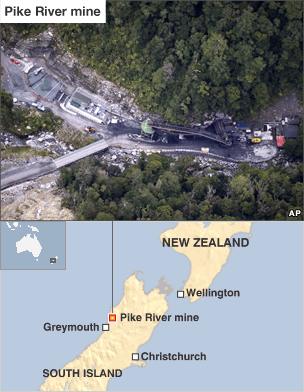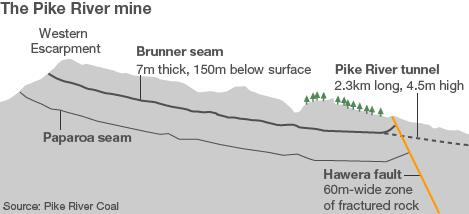New Zealand miners missing after explosion
- Published
Mayor of Grey District Tony Kokshoorn: "At the moment we cannot contact the miners"
Twenty-seven miners are missing after an explosion at a remote coal mine on New Zealand's South Island.
The mayor of Greymouth, 46km (29 miles) south-west of the Pike River mine, said the situation was "pretty serious" but that rescuers were on hand.
However, concerns about the possibility of another explosion have delayed attempts to enter the mineshaft.
There has so far been no contact with the missing miners, whose friends and relatives have gathered at the scene.
Earlier, two workers walked out of the mine with moderate injuries.
'Charred trees'
The explosion at the Pike River mine is believed to have happened at around 1530 local time (0230 GMT).
An electrician went into the mine at 1550 to investigate a power failure, and 1,500m (4,920ft) into the shaft he discovered the driver of a loader who had been blown off his machine. He then raised the alarm.
They and one other miner later emerged safely from the mine and told officials that three others were also making their way to the surface. They came out sometime later.
The operator of the mine, Pike River Coal, said that 27 workers remained unaccounted for - 15 of its staff and 12 local contractors.
Its chief executive, Peter Whittall, also denied that a body had been found.
"I've not had any reports of that at all," he said. "We've had two miners who've walked out of the mine and they're currently being spoken to and treated on the surface. We've had no communication with anyone else underground at this stage."
The two miners who emerged earlier had moderate injuries, Mr Whittall said. They are being treated at the hospital in Greymouth.
Mining experts said it could have been a methane gas explosion, a coal dust explosion, or a combination of both.
Television footage showed charred trees and light smoke billowing from the top of the mineshaft. A nearby cabin had been blown away, suggesting there had been a powerful blast.
'Worrying time'
Specialist mine rescue crews, ambulances and helicopters rushed to the mine as soon as the blast was reported.
However, the helicopters were later sent back to their bases, when it became apparent that the rescue effort might take days.

Police spokeswoman Barbara Dunn said rescuers were still assessing the safety conditions inside the mine, and making sure the ventilation system was functioning as there was a potential for a build-up of gas.
Until that happened, it was unsafe for rescuers to enter the mine, she added.
"They're itching to get in there and start looking for other people and a bit frustrated at having to stand and wait," Ms Dunn told reporters. "There is concern that ventilation inside the mine shaft may be compromised by the power outage."
Mr Whittall said every worker at Pike River carried a "safety rescue device at all times including a breathing apparatus with oxygen".
"The men are between 2 and 2.5km inside, but because the mine drills into the side of the mountain they are probably only 120m below the surface," he said.
"The issue for the rescue team will be to ensure that the ventilation underground is adequate for them to go in and find the men."
Mr Whittall added that the men might not be trapped, because they were trained to find oxygen stores and a place of safety, and then await rescue. The oxygen stores would allow them to survive for "several days".
Prime Minister John Key said the government would put whatever resources were needed into the operation, and stood ready to support the miners' families.
"Our hearts and thoughts go out to them at this time. It will be a very worrying time for them," he said. "We will do anything humanly possible to aid the miners and to rescue them."
'Slow recovery'
Greymouth's Mayor, Tony Kokshoorn, told the BBC that the friends and relatives of the missing miners were "hanging on to hope".
"The rescue crews are doing a magnificent job. They are well trained for this and are doing everything they can. But this is going to be a very slow recovery," he said.
"Everybody knows what they are doing, but it's just a patience game. We've got support people everywhere. We've got families starting to arrive at the scene. We're just consoling them at the moment. We're setting up places for them to go.
"We're all hoping that everything will turn out all right, but it's looking pretty serious at the moment," Mr Kokshoorn added.
The Pike River mine, which employs some 150 people, has been operational since 2008 and runs deep under the Paparoa Ranges on the rugged western coast of the South Island.

It accesses the Brunner and Paparoa coal seams via a 2.3km (1.4-mile) tunnel under the mountains, which then branches out into sub-areas.
The 5.5m-wide (18ft), 4.5m-high (15ft) shaft slopes uphill near the top of the Paparoa Ranges, and bisects the Hawera fault, through which a large quantity of methane gas is known to leak.
In 2008, the former head of Pike River Coal said that because the tunnel passed through the fault, flameproof mining equipment had to be used.
Pike River is on the opposite side of the Paparoa Ranges from the former Strongman mine, where an explosion killed 19 miners in 1967.